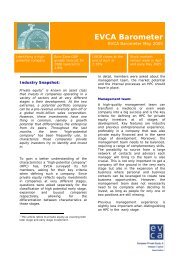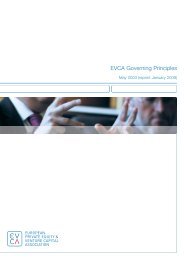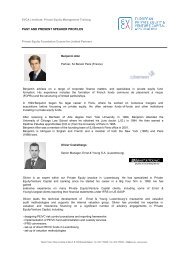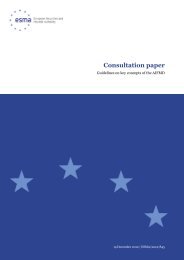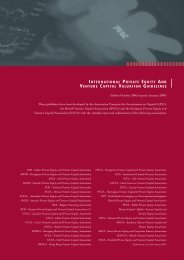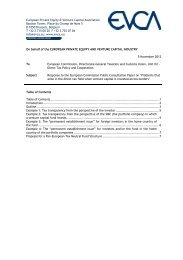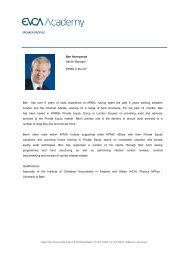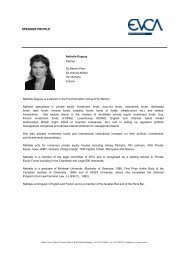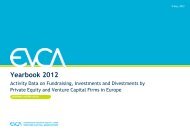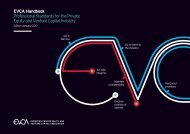Risk Measurement Guidelines - EVCA
Risk Measurement Guidelines - EVCA
Risk Measurement Guidelines - EVCA
You also want an ePaper? Increase the reach of your titles
YUMPU automatically turns print PDFs into web optimized ePapers that Google loves.
Exhibit 4Under scenario 2, the gain is 7.73 EUR p.a. and under scenario 3, the fund would lose 16.38 EUR p.a.Based on these results, the density function for the fund’s valuation after one year can be determined:> Should scenario 1 materialise, after one year the fund would be worth 53.33 EUR + 4.24 EUR = 57.57 EUR> Should scenario 2 materialise, after one year the fund would be worth 53.33 EUR + 7.73 EUR = 61.07 EUR> Should scenario 3 materialise, after one year the fund would be worth 53.33 EUR - 16.38 EUR = 36.95 EURBased on these valuations, the risk of losing any capital until the next year can be assessed.Let us now discuss another example to compare thecalculation method to the time-series calculation approachdescribed before.4.2.2 Approaches to cash flow-based models for privateequity fundsCash flow-based models for private equity funds can benon-probabilistic (i.e. deterministic) or probabilistic.Non-probabilistic models can be a solution in situationswhere too little data is available for a probabilistic approach.Such models require a limited number of parameters which– due to the lack of data – will be highly subjective. Because ofthese limitations, non-probabilistic models have to be robustand relatively simple. They do not produce ranges for theoutcomes and therefore do not capture volatility of cash flowsand can only be used to manage liquidity risk for very large,diversified portfolios of funds. Consequently, non-probabilisticmodels can also only be applied in very specific situations.Practitioners tend to prefer models that are probabilisticbecause they show a range of potential outcomes.Probabilistic models base their forward-looking assumptionson historical data. This approach is, of course, based onthe major assumption that historical data is representative.The more data that is available and the longer its history,the more likely it is that the dynamics of the market will becaptured. The main question is how to adjust the historicalcash flows to fit the development of a specific fund.Here, various approaches are possible. One way would beto compile a statistic of cash flows for each step in a fund’slifecycle and draw from this statistic independently for everycash flow. This of course assumes zero autocorrelationbetween consecutive cash flows, which might not always bejustifiable 13 . Taking account of autocorrelation would be moreconvincing, but will make the model far more complicatedand requires the introduction of other assumptions thatwould be difficult to justify as well.It would be more consistent to collect total cash flow historiesof a fund rather than splitting the history into the variousdistributions of cash flows for each time period. In the end,it comes down to whether such data is available and its quality.For investors just starting in an asset class and without accessto large historical datasets, a non-probabilistic model may bethe only feasible option.Cash flow volatility-based models can be built using a“bottom-up” approach where the fund’s risk is derived fromthe risk measurement of the individual investee companies,or through a “top-down” approach where the fund’s risk isdetermined, for example, by comparing it to other funds.The comparison between funds is made on the basis of netreturns to limited partners, while bottom-up approachesrequire that the fund’s specific distribution waterfall 14 isfactored in.13 See Weidig (2002)14 See Section 10 Glossary<strong>EVCA</strong> <strong>Risk</strong> <strong>Measurement</strong> <strong>Guidelines</strong> 2013 I 23



